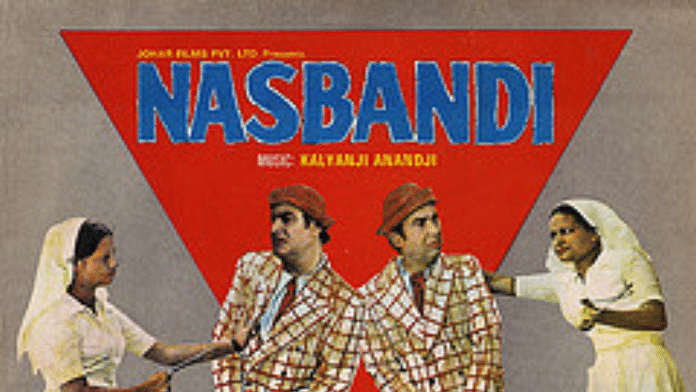As elections approach, a group of Jan Gan Desh residents form ‘Kaali Party’ and nominate poor Gangu as the candidate for the post of president. The year is 1975, and the party’s young workers, Meera Devi and Gopal, start to train Gangu aka Prof Gangaram in the politics of ’70s India — with a ‘lesson on acting’ before he delivers a speech. Impressed by his learning skills, they give him a whole bottle of ‘Netagiri’ tonic, a pill for ‘Inquilab’, and an injection of ‘Samaajwad’. The perfect neta is ready.
This scene, from the 1977 satire film Kissa Kursee Ka, depicts the political realities of a time when high inflation, corruption, scarcity of food, and unemployment plagued the nation.
Movies such as the recently released The Kerala Story (2023) and The Kashmir Files (2022), which stirred controversy across the nation, are no exception. Bollywood has been a mirror to all the topsy-turvy but significant political and social events in India’s post-Independence history. Even before the dreaded Emergency was announced 48 years ago, Hindi cinema captured the gloomy build-up of popular disquiet — from inflation to unemployment to industrial distress in movies like Roti Kapada Aur Makaan (1974), Mere Apne (1971), and Namak Haraam (1973). The Emergency was imposed to quell this rising tide of public anger. And filmmakers diligently and bravely recorded the horrors through satire and realism.
Also read: Women politicians in Indian cinema emerged with Indira Gandhi. Now they’re just placeholders
The Indira ‘aandhi’
“Salaam kijiye aal-e-janab aaye hain,
yeh paanch saalon ka dene hisaab aaye hain”
From the 1975 movie Aandhi, directed by Gulzar, this satirical song showed a woman politician, ‘Aarti Devi’, in the likeness of Indira Gandhi — having donned a white sari with blue borders and a low hair bun with a streak of grey, she campaigns from door to door for an election. This was set in the ‘Indira wave’ that subdued later on when the former PM introduced stringent measures such as the Maintenance of Internal Security Act (MISA) 1971, compulsory sterilisation, and a nationwide crackdown on media and journalists.
Aandhi shows how Aarti Devi takes her father’s political legacy forward and leaves her familial concerns behind. There’s a portrayal of Jayaprakash Narayan or JP too — a character called Chandersen is shown campaigning as an opposition leader and saying “Mujhe koi shauq nahi hai election ladne ka (I am not interested in contesting the election)”. The film is interspersed with pictures of Jawaharlal Nehru and Indira Gandhi in the backdrop.
Gandhi Tere Desh Mein
Nasbandi was perhaps the best depiction of the forced sterilisation campaign, which was started by Sanjay Gandhi in 1975 and vasectomised nearly 8.3 million men.
“Ek Bharat mein ban gaye Jallianwala Bagh hazaar; Gandhi, tere desh mein ye kaisa atyachaar” — sang Kishore Kumar in the song titled Gandhi Tere Desh Mein from the movie. The song gave voice to the popular lament—how disparate the country had become from Gandhi’s vision.
Directed by IS Johar, Nasbandi stars the duplicates of the famous actors of the time, including Amitabh Bachchan, Shashi Kapoor, Rakesh Khanna, and Manoj Kumar, among many others. The film shows how the Indira Gandhi government specifically targeted the lower classes during the sterilisation drive to achieve population control goals. As opposed to compulsory vasectomy, Nasbandi suggests voluntary family planning as a solution. From labelling authorities and medical staff as ‘modern Duryodhans’ to lyrics like “Kya mil gaya sarkar Emergency laga ke, nasbandi kara ke, hamari bansi baja ke”, the film faithfully depicts the tumultuous times.
Also read: Shatranj Ke Khiladi to Sadgati — when Satyajit Ray found his inspiration in Premchand
Desire for beauty
Another important aspect of Emergency-era India that Bollywood movies capitalised on was the demolition of slums and homes at Delhi’s Turkman Gate in 1976. As per the Shah Commission Report, under Sanjay Gandhi’s ‘urban renewal’ programme, nearly 1,40,000 tenements were razed to the ground and 7,00,000 pushed out into the rain and cold.
Madhur Bhandarkar’s 2017 movie Indu Sarkar shows the trauma that the massacre inflicted on people. The film is peppered with sharp dialogues like “Emergency mein sirf do hi log chalte hain—ek policeman aur ek yes-man (Only two people make things happen in Emergency — a policeman and a yes-man)”. The stuttering Indu (Kirti Kulhari) is the voice of the oppressed masses, who is shaken to the core after seeing the demolition and brings home two children who were left destitute in the debris. Her husband, Navin Sarkar (Tota Roy Chowdhury), a staunch supporter of the government and an opportunistic civil servant, eventually leaves her. Sanjay Gandhi (Neil Nitin Mukesh), meanwhile, dismisses anybody who dares to dissent. The movie highlights how middle-class families during the ’70s were often torn between morality and politics. In the film, Navin embodies the arrogant attitude of the government, while the resistant attitude of the masses is represented by the stuttering Indu. It ends with Indu saying: “Nasbandi, Pressbandi, Morcha bandi, har taraf paabandi”.
Winning the janta over
Former Congress and Janata Party MP Amrit Nahata made the controversial film Kissa Kursee Ka in 1977, which parodied Sanjay Gandhi. The information and broadcasting ministry raised 51 objections to the movie, and the Indira Gandhi government banned it. A reworked version of the movie was released in 1978.
The protagonist, Gangu (Manohar Singh), is a corrupt politician aspiring to win over the public, personified by a woman named Janta (Shabana Azmi), who gets easily swayed.
Before becoming a politician, Gangu is shown promoting a medicine called “Sanjay Sanjeevani”—one tablet for those who are childless, two for those who have more than they can handle. But the pill is not to be used by bachelors.
Throughout the film, Janta is kicked, abused, starved, and inflicted with misery. She eventually hangs herself.
For all the crackdown during the Emergency era, Bollywood did the task of historians — archiving and observing one of the worst periods in Indian history.
(Edited by Humra Laeeq)






